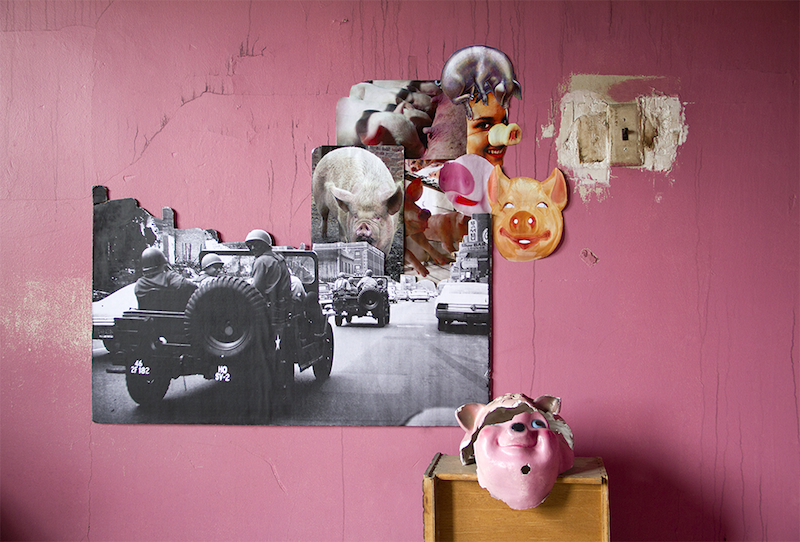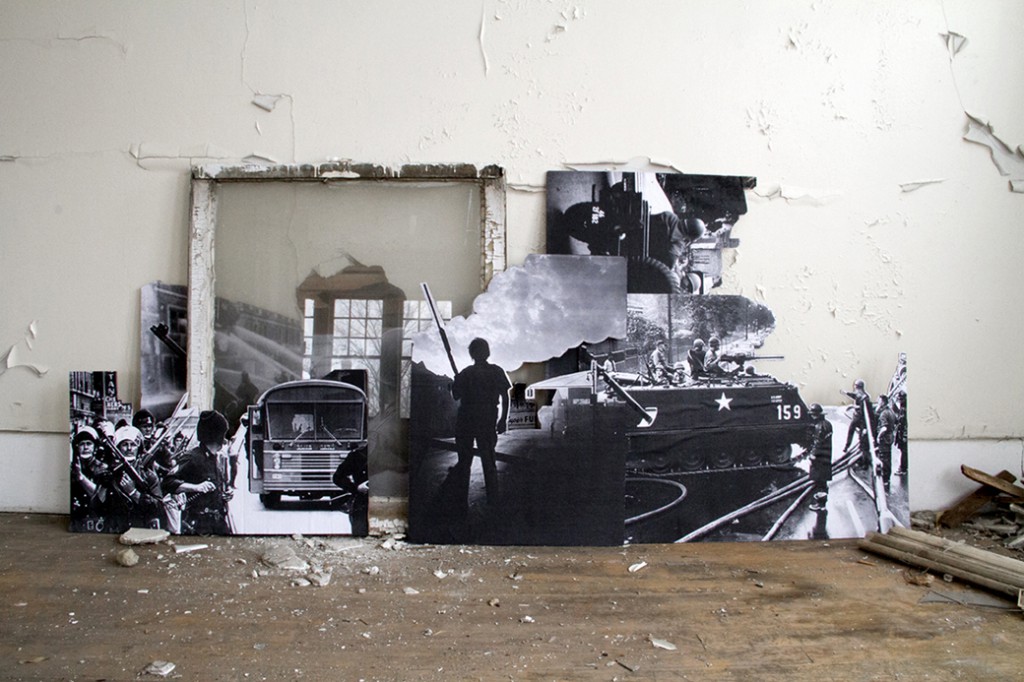
Shanna Merola, 12th & Clairmount, from the Black Day in July series, 2012; archival pigment print; 20×30. Courtesy the artist
It was an unlikely but veritable feast. Gathering with friends at a makeshift table created from repurposed wood and supported by stacks of milk crates, we sat in a home, without yet its oven. But dishes of hot food steadily emerged from nearby houses. Salad filled the basin of a carved log running the length of the table, serving as a communal bowl. A brick hearth under construction hinted at the upcoming installation of a wood-burning stove; in its absence, the propane heater would suffice until enough warm bodies squeezed around the long table. A large freezer doubled as our side buffet, containing the butcher’s packaged cuts of two pigs that had been raised in my friend Kate’s backyard and recently slaughtered. It was an impressive spread both because of and in spite of its unconventionality. The meat was also, hands down, the best ham I’ve ever had.
This gathering occurred in the midst of my time in Detroit, Michigan, a stay spanning the transition from fall to winter that became an amalgam of projects, collaborations, and installations with friends and artists in the area. My aim is not to make much ado about the ruinous state of Detroit or the beautiful decay often glorified by its visitors. I acknowledge the harsh realities the city currently faces, well documented by the steady stream of recent press about the city’s bankruptcy case and its effects. For those who do not know the place, and perhaps for a good number who know it all too well, the city is perceived as a failed system—sprawling and unruly, vexing, in defiance of expected notions of progress. It might be reasonable, then, to project that Detroit could also defy traditional responses to the notions of failure. By honestly examining the breakdown of one system and the subsequent reconfiguration of another, one could see failure as the most generative force of all.
Though I’d gone to graduate school near Detroit, and often went to the city for my work, it was not until my return last year that I experienced the place in all its conflicted glory. As a visiting artist with limited funds and no transportation aside from a bicycle and the occasional borrowed car, I learned the city could be an indifferent beast. Trying to navigate the region’s public transportation system, I found the bus ride between Detroit and my studio in Pontiac to be a sobering one indeed. On the flip side, I experienced impromptu bonfires, shared meals, slow mornings, and expansive studios where strong work thrived. At the time, I felt the city mirrored my mind while I sorted through the layers of a strange postgraduate period. It was something akin to what Rebecca Solnit describes in A Field Guide to Getting Lost:
A city is built to resemble a conscious mind, a network that can calculate, administrate, manufacture. Ruins become the unconscious of a city, its memory, unknown, darkness, lost lands, and in this truly bring it to life. With ruins a city springs free of its plans into something as intricate as life, something that can be explored but perhaps not mapped.1
As artists, we are encouraged to embrace failure and the unknown as key elements of our process. Traversing the gap between intention and realization, we pay homage to that which we’ve built while contending with the doubts and mysteries of what we’re trying to create. Expectation and experience inevitably collide, forcing us to pick up the pieces and recalibrate. It is in this collision that the process becomes more unsettling—and more compelling for those willing to keep going.
Shanna Merola, 12th & Clairmount, from the Black Day in July series, 2012; archival pigment print; 20×30. Courtesy the artist
The work of the Detroit-based photographer Shanna Merola beautifully illustrates this process of dismantling and reconstruction. Deeply invested in researching the definitive events of Detroit’s history, such as the Rebellion of 1967,2 Merola employs layered imagery and related semiotics in the creation of site-specific installations. The open-endedness of the work is one of its strengths, inviting viewers to revisit these events and symbols as they are compounded by the complexities of Detroit in the present. History and authenticity become permeable notions but are no less integral to the continuing tale.
As she explains in her artist statement, Merola subverts the original intent of historical photographs in order to “provoke a more complex understanding of race and class history than what is currently offered through the existing, mainstream narrative.” Further, she works to weave these layered narratives back into the present, conducting video interviews with residents of Detroit who lived near affected sites and experienced the rebellion firsthand. Adopting excerpts from these testimonials as the accompanying texts to her images, Merola pays homage to the dissenting voices and turbulent moments of the past. But more importantly, she illuminates the ripple effects of such events—how they influence the people of Detroit now.
Shanna Merola, 12th & Clairmount, from the Black Day in July series, 2012; archival pigment print; 20×30. Courtesy the artist
Recently, I celebrated another meal with friends that coincidentally marked a year since the aforementioned feast. Though I was many miles and days away from that Detroit period, I felt that a piece of me still sat at that rough-hewn table, immersed in the unknown and seeking resolution. Perhaps the difference is that I now understand the productive power of those feelings; they are necessary forces. I remember the mornings I would bundle up to ride through Detroit’s quiet streets, strangely awed and comforted each time I first saw my breath rise in the cold air. It is a simple but effective illustration: the embrace of vulnerability is a revelation.
________
1 Rebecca Solnit, A Field Guide To Getting Lost (London: Penguin, 2005), 89.
2 The Rebellion of 1967 is more commonly known as “the Detroit riots.” Merola prefers the former appellation and requested that I use it here.
